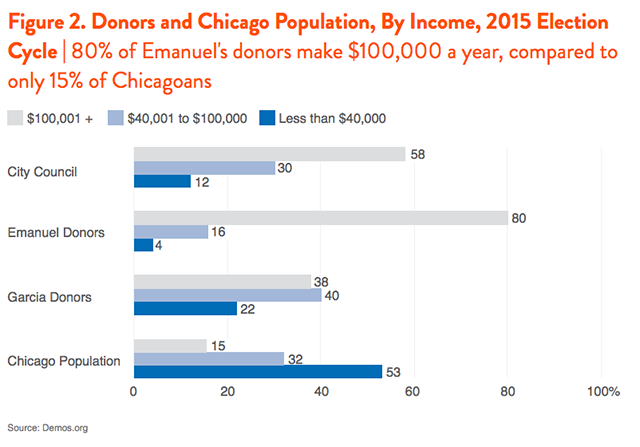Rich, White Political Donors Have Been A Disaster For Chicago
By aaroncynic in News on Apr 28, 2016 9:17PM
It’s painfully obvious to the majority of Chicagoans who don’t live in the Loop or other ultra-wealthy enclaves that there are really two windy cities—one for the 1 percent and one for the rest of us. While Chicago might not be a total Dickensian nightmare, in the past five years its residents have lived through the largest closure of public schools in history, the first teacher’s strike in two decades, half the city’s mental health clinics closed, a disproportionate amount of violence in poorer neighborhoods of color, and a general culture of corruption that’s world famous.
A study released Thursday by Demos—a left-leaning public policy organization—and first reported by David Sirota at the International Business Times, shows that Emanuel’s near-$25 million war chest was filled mostly by ultra-wealthy white people, many of whom aren’t even from Chicago.
Despite Rahm being reviled by a good portion of Chicagoans who gave him a record low approval rating of 27 percent in February, he managed to keep his grip on the fifth floor of City Hall last year taking 55 percent of the vote over challenger Jesus ‘Chuy’ Garcia. While it might be arguable that some Chicagoans are having buyer’s remorse for the second time—particularly after the way his administration handled the killing of several African-American teens by police—the study shows he was able to keep a huge portion of the electorate in line by scooping up the majority of his donations from mostly rich white people.
Though only 39 percent of Chicagoans are white, Emanuel’s donors were 94 percent white, and nearly three quarters of them make more than $100,000 a year. 90 percent of the money for both candidates came in donations of more than $1,000, and more than half (52 percent) came from outside Chicago. Only 36 percent of Emanuel’s donors lived in Chicago compared to 56 percent of Garcia’s.
City Council races too, came with their own disproportions. While a larger number of donors to aldermanic campaigns lived within the city boundaries—65 percent—some 60 percent of them were wealthy individuals, and nearly 80 were white and male.
There’s geographic disparity too. The five wards with the largest number of donors to both mayoral and City Council campaigns accounted for 42 percent of all donors, yet only 13 percent of Chicagoans live in them. Those wards are mostly well-to-do and predominantly white encompassing neighborhoods like Lincoln Park, the Gold Coast, River North, Lakeview and almost all are on the North Side of the city except downtown.

That the donor base keeping Emanuel and City Council in power is rich and white—which is overwhelmingly not the makeup of Chicago—has direct effects on its residents.
“Chicago’s democracy is being distorted by an overwhelmingly, white, wealthy and male donor class,” reads the study. Thanks to money counting for much more influence in politics than actual votes, city policies reflect the wishes of the donors rather than residents or voters.
The study referenced a survey called the Survey of Economically Successful Americans, which compared the policy preferences of those with a median wealth of $7.5 million. The study showed that wealthy political donors are much less likely to believe that government has a role in caring for its citizens than the average person. While nearly three-quarters of the general public believes government should ensure citizens receive a college education, have a higher minimum wage, and that no one should go without adequate food, clothing or shelter, only about 40 percent of wealthy people do. While nearly 90 percent of average Americans believe government should spend whatever necessary to ensure all children get a decent public education, only 35 percent of the rich agree.
The policy preferences of the wealthy and well to do shine brightly in a city like Chicago, where the school and clinic closures were overwhelmingly in poor neighborhoods of color, where many South and West Sides neighborhoods are starved for resources, and where TIF money—allegedly earmarked for struggling and blighted neighborhoods—is siphoned to big businesses downtown.
Leveling the playing field won’t be easy. Looser-than-ever campaign finance rules allow unfettered spending which makes every last election the most expensive one in history. The study however, recommends the passage of a little talked about ordinance in City Council introduced by Ald.s Michelle Harris (8th), John Arena (45th) and Joe Moore (49th) and championed by the group Common Cause, would create a publicly financed donor matching system of up to $175 Progress Illinois reported in February. Candidates participating could not accept more than $500 and there would be limits on the amount of public funds a candidate could receive. While it certainly isn’t a solution to keeping people with a Scrooge McDuck sized moneybin out of elections, it does give those without one a little bit of a leg up.
“It would reduce the influence of big money donors, creating a more equitable democracy,” concludes the study. “By empowering small donors, Chicago would reinvigorate its democracy.”